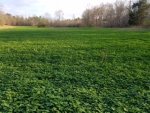Welcome Guest!
You are using an out of date browser. It may not display this or other websites correctly.
You should upgrade or use an alternative browser.
You should upgrade or use an alternative browser.
Clover
- Thread starter oppthepop
- Start date
That is some gorgeous clover!
oppthepop
Senior Member
Triple C
Senior Member
That is some gorgeous clover!
X2! Great looking plots that will be feeding critters year round.
DawgDr.
Senior Member
Looks great! I am putting in clover plots this year for the first time so any advice you are willing to share would be appreciated. Thanks
Jim Boyd
Senior Member
That looks awesome Opp!!!!!!
oppthepop
Senior Member
Hey DawgDR we planted wheat and oats last fall and overseeded with the clover. We then applied chicken manure in the early spring. We also sprayed the clover with Slay and Arrest - both products from the Whitetail Institute, to kill grasses and broadleaf weeds. We also mowed the wheat when it matured and dried out. I hope this helps!
godogs57
Senior Member
Looks great! I am putting in clover plots this year for the first time so any advice you are willing to share would be appreciated. Thanks
One word: PH. Your soil ph absolutely has to be right or you’re just wasting your time and money. Soil testing is essential here...you have to know the what you are dealing with. After you soil test, apply lime sufficiently to raise the ph to 6.8 or better. Allow six months for the lime to “work”. I generally lime around Christmas/New Years.
Imperial Whitetail products are the very best on the market, bar none.
oppthepop
Senior Member
Agreed!
Agreed Godawgs! We did the lime a year earlier actually, but i forgot to mention that. It makes all the difference in the world.
Agreed Godawgs! We did the lime a year earlier actually, but i forgot to mention that. It makes all the difference in the world.
DawgDr.
Senior Member
Do yall send your soil tests to IW or just use the county agent?
godogs57
Senior Member
County agent. Think it’s around $7 per sample. In your plot, take several random samples with a spade, shovel, etc down to “plow depth”. 8”-12” or so will do. Put your samples in a plastic bucket, not a galvanized bucket! A plastic mop bucket, five gallon bucket or similar bucket is fine. A galvanized bucket can throw the results of the test off.
Mix thoroughly and take about a coffee cup sized sample from the bucket for your test.
Mix thoroughly and take about a coffee cup sized sample from the bucket for your test.
BuckNasty83
Senior Member
County agent. Think it’s around $7 per sample. In your plot, take several random samples with a spade, shovel, etc down to “plow depth”. 8”-12” or so will do. Put your samples in a plastic bucket, not a galvanized bucket! A plastic mop bucket, five gallon bucket or similar bucket is fine. A galvanized bucket can throw the results of the test off.
Mix thoroughly and take about a coffee cup sized sample from the bucket for your test.
10-12" is way too deep.
Soil testing is a common practice for cropland grain fields as it still is the best method to determine soil fertilizer and lime requirements. It is less commonly used on pasturelands but still is highly recommended if farmers and ranchers are considering nutrient amendments to those fields to increase forage yields and/or stocking rates. Long term research at Michigan State University has found that pasture fertility improvements such as lime and fertilizers can increase forage dry matter yields from 25 – 75 percent on an annual basis. These additions can be economical, even at today’s fertilizer prices, if the farm or ranch needs more pasture growth to graze. But when these costs approach $50 - $100 per acre or more, accurate soil testing is of utmost importance.
According to Michigan State University Extension many farms are sampling pasture fields too deep, resulting in test results that sometimes over apply fertilizer. Michigan State University (MSU) soil testing guidelines recommend the sampling depth should be the depth of tillage. For most of today’s tillage equipment this is a range of 6 – 9 inches. But a major exception in these guidelines is when there is little or no mixing with tillage of the soil. Many pastures have never been tilled, and a majority of those that have were not tilled the in the last ten years. These fertilizer and lime additions are being applied to the sod surface and are only able to naturally peculate down into the sub surface with rainfall and with soil organism movement. This movement is highly variable depending upon soil type and seasonal rainfall amounts, but realistically we should expect the total movement to be 2 - 4 inches into the soil. Thus in pasture fields where tillage is not planned, MSU recommends the soil sampling depth be a maximum of 4 inches.
A common scenario in many counties is for a well intending farmer to bring in a soil test for pastureland and when filling out the paperwork state that they sampled it on average eight inches deep. When advised this is too deep for pastureland, they reply “that’s OK, I want to test the entire root zone to make sure things are good”. When the test results come back the fertility is low and the recommended fertilizer rate is high sometimes costing over $100 per acre. The farmer may realize such a high rate will not be profitable and will hopefully apply only what the farm budget allows. Others that have fertilized and/or applied manure to the ground in the past feel the test results should be higher and thus question the accuracy of the test. Some of these farms then become mistrusting of soil testing. Others may faithfully follow the soil test fertilizer recommendations, over-applying nutrients, wasting dollars and potentially adding un-necessary nutrients to the environment.
Phosphorus (P) nutrients from fertilizer and manure bind tightly with soil particles and stay put where they are deposited. They move very little into the deeper soil profile. Potassium (K) is slightly more mobile than phosphorus, but without tillage, will take years to move down over 4 inches in depth. There is plenty of opportunity for the grass and legume feeder roots to find these nutrients in the soil and utilize them for growth even though they are held closer to the soil surface. Nitrogen is mobile in the soil once moisture moves it into the soil surface, but since regular soil tests are not measuring soil nitrogen levels anyway, there is no concern about depth of sampling pertaining to pasture nitrogen.
Thus it is critical for pasture P and K soil testing that we only sample to a depth of 3-4 inches if no tillage is planned. In one recent evaluation on a long running MSU pasture fertility trial the difference between sampling the same field at a 4 inch depth versus a 7 inch depth was 228 percent more P2O5 at the shallow depth - 66 ppm versus 29 ppm. K2O was 180 percent higher at the 4 inch depth with 155 ppm vs only 86 ppm at the 7 inch depth. The MSU soil test was recommending P and K fertilizer in addition to nitrogen when sampled at the 7 inch depth. At the 4 inch depth only nitrogen fertilizer was recommended. Same field, same soil testing lab – the only difference was the sampling depth. This was a cost savings of over $60 per acre in fertilizer, just by sampling the pasture at the proper depth
Dirtroad Johnson
Senior Member
DawgDr.
Senior Member
Great info, thanks !
BluewaterFever
Senior Member
Beautiful plot, we have one going now but does not look as good. We are going to plant another acre this fall and follow your tips.
Thanks for the info.
Thanks for the info.
Similar threads
- Replies
- 0
- Views
- 846




